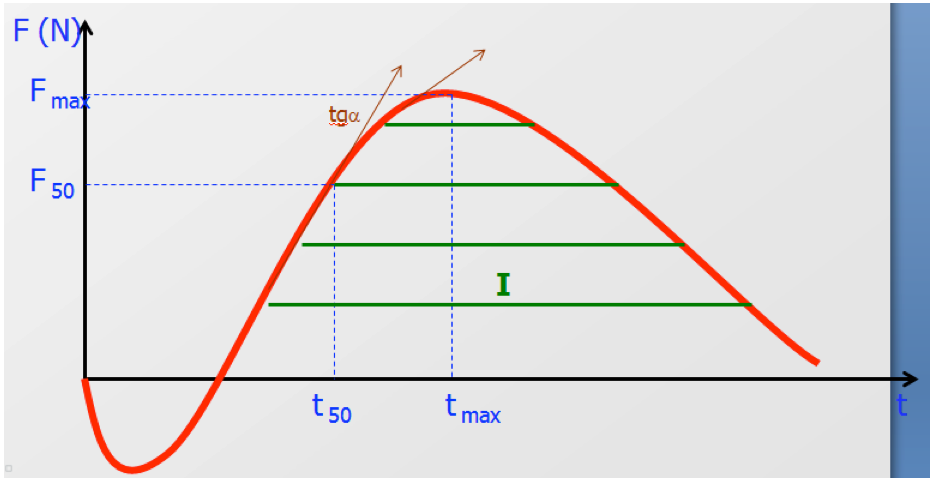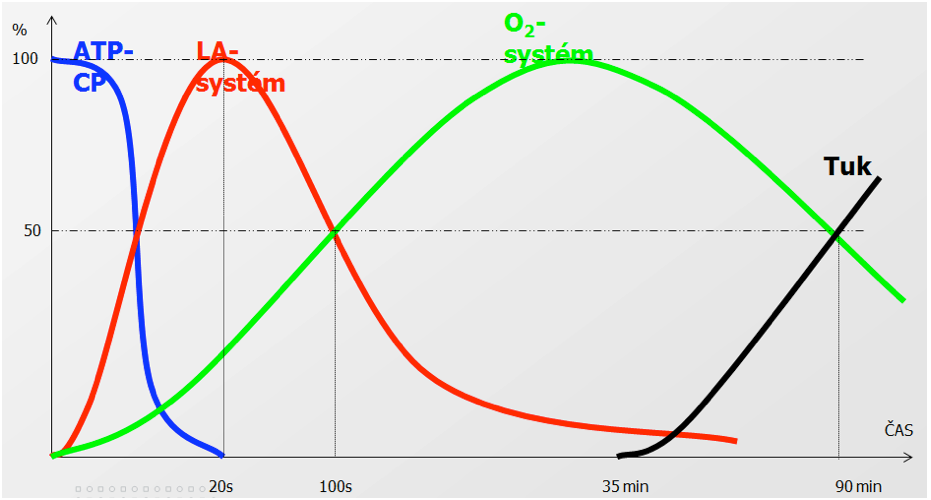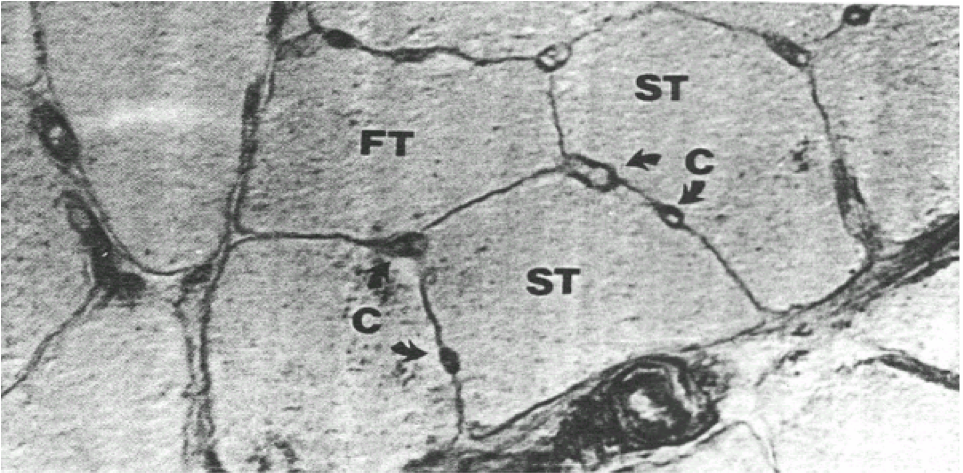
Force Ability
Force ability is an ability to overcome or keep outside resistance with muscle contraction.
Types of contractions:
1) Isometric contraction: muscles are not shortened
2) Isotonic contraction:
a) concentric – flexors shorten (movement towards body)
b) excentric – extensors shorten (movement away from body)
Structure of Force Abilities
1) Static force: it is isometric contraction (holding time of pull-up, half lever, leaning rest, etc.)
2) Dynamic force:
- Explosive force: maximum acceleration of own body or object (jumps, throws, casts)
- Quick force: repeated muscle load with non-maximum acceleration and non-limit resistance (running, swimming, track cycling, etc.)
- Slow force: getting over limit resistance without acceleration (maximum force of bench press, deadlift, squat, etc.)
3) Endurance force: long-term repeated getting over resistance (rowing, canoeing, road cycling, etc.)
Evaluating maximum force:
1) Absolute force: weight of load expressed in kilograms
2) Relative force: absolute force converted to the weight of athlete in kg (some sports then make use of weight categories)
Motor tests:
1) Static force: measuring endurance time with given resistance (holding time of pull-up, half lever, etc.)
2) Dynamic force
Explosive force: measuring of covered distance or height (standing jump, block or smash jump, medicimball throw-off, sum total of right and left kicks)
Quick force: measuring mainly the number of repetitions in certain time or time needed to carry out given number of repetitions (number of crunches in one minute, ......)
Slow force: measuring maximum force in a given exercise (maximum force in kg for deadlift, squat, bench press, etc.)
3) Endurance force: the highest number of repetitions or number of repetitions in a longer time period (number of push-ups, pull-ups, half levers, etc.)
Speed Ability
It is an ability to carry out a short-term locomotive activity (up to 20 s) as fast as possible.
Related Relationships:
1) Influence of Heredity ( 90 % ): proportion of quick and slow muscle fibers (Q:S Þ 1:1 – 9:1)
2) Influence of other locomotive abilities:
a) explosive force
b) speed endurance
c) moveability (10-16 % of performance)
Dynamometry (Kistler’s Plate)
Record of effort in time (dynamo graph):
I – Force impuls: determined by total area below curve (integral of given fucntion)
Fmax – Absolute force: determined by biggest force
Explosive force is determined by so-called force gradient: tg a = Fmax / tmax or F50 / t50
Fig. 12 Scheme of the course of take-off on a dynamometric board (Vobr, 2001)

Speed Ability
It is an ability to carry out a short-term locomotive activity (up to 20 s) as fast as possible.
Speed ability is to a considerable extent influenced by heredity, other locomotive abilities and training. Heredity influences mainly the number of quick and slow muscle fibers (Q-S: 1-9 up to 9-1) and the speed of impulse transmission within central nervous system. Out of the other locomotive abilities it is force ability, speed endurance and joint moveability (flexibility) which influence speed the most.
Single-sided (stereotype) focus of training on speed can result in speed hedge.
Structure of Speed Abilitites
1) Reaction speed ability: from stimulus (visual, touch, audio) till the beginning of movement. It is divided into:
a) simple: one response to one stimulus (usually around 0.15-0.20 s)
b) selective (Hick’s Law): Reaction time to more stimuli is equal to logarithm of the number of alternatives.
2) Action (implementation) ability: from the beginning of movement till its end
a) acceleration: usually from the start until reaching maximum speed of locomotion
b) frequency: after reaching maximum speed of locomotion
c) speed with change of direction: short stretches with maximum speed of motion
3) Speed of individual movement: acyclic movements – shooting, boxing, fencing
Speed Abilities Diagnostics
With motor tests:
a) Reaction speed: catching a falling bar, ruler, etc.
b) Frequence speed: taping tests both lower and upper limbs
c) Speed with change of direction: shuttle run, stellar run
In laboratory:
a) Reaction speed: reaction meter with different number of alternatives
b) Frequence speed: scaler for upper or lower limbs, video capture
c) Acceleration speed: video capture, photosensors, etc.
Endurance Ability
It is an ability to carry out motor activity without any cease in intensity (intensity is determined by the locomotive task).
Energy supply:
1) Creatine phosphate (ATP – CP): supply for 2-20 contractions
2) Anaerobic glycolysis (LA – system): producing ATP and lactate
3) Aerobic glycolysis (O2 system): producing ATP, CO2 and H2O
Energy supply:
1) ATP (phosphagen): 20 – 30 kJ
2) Glycogen: 6,000 – 7,500 kJ (R = CO2/O2= 0.9)
3) Fat: 200,000 kJ (200 MJ) (R = 0.7)
4) Proteins: (R=0.8)
Structure of Endurance Abilities (EA)
1) According to the extent of muscle involvement:
Local endurance ability (1/3 of muscles)
Global endurance ability (2/3 of muscles)
2) According to duration:
High-speed EA: 0-20 s (ATP – CP system)
Short-term EA: 20 s – 2 mins (LA system)
Middle-term EA: 2 – 10 mins (O2 system)
Long-term EA: I 10 – 35 mins (glycogen)
II 35 – 90 mins (glycogen + fat)
III 90 – 6 hrs (fat)
IV nad 6 hrs (proteins)
3) According to outer manifestation:
Static endurance ability (holding time of pull-up)
Dynamic endurance ability (crunches, running)
4) According to the share of other abilities:
General endurance (aerobic capacity, aerobic performance)
Special endurance (games, swimming, running, etc.)
Share of individual energy systems
Fig. 13 Scheme of individual energy systems involvement (adapted from Dovalil et al, 2002, 57)

Biological conditioning of endurance
It means fluent supply of oxygen and energy resources to muscle cells and parallel outflow of waste products of metabolism.
1) Heredity: proportion of quick and slow fibers.
2) Cardiopulmonary system: its functioning can be well influenced by training; the influence can be of the following kinds:
a) Respiration system: inflow of oxygen into organism depends on ventilation per minute (breathing capacity x breathing frequency) and utilizing oxygen in the air.
b) Circulatory system: inflow of oxygen into muscle cells depends on heart capacity per minute (heart capacity x heart frequency)
c) Blood vessels supply in the muscle: number of capillaries surrounding muscle fiber
Fig. 14 Microscopic view of muscle intersection (Musculus gastrocnemius) of a first-class marathoner. Note the capillaries surrounding each muscle fiber and secure interchange of oxygen and energy resources. The average number of capillaries for 1000 mm2 of a muscle intersection is 0.84 with an untrained person, 0.94 with a medium trained person and 1.25 with an endurance trained person. (Wilmore & Costill, 1999)

Endurance Abilities Diagnostics
Under laboratory conditions, it is possible to use standardized tests which are based on a presupposition that the smaller the functional changes with the same load are, the more tireless the trained person is. It usually concerns gradual load with measuring functional feedback of organism. W170 and V02max tests are most often used for aerobic endurance. For anaerobic endurance, it is the step test.
Under field conditions, it is possible to use performance tests in the form of long-term cyclic load. Most of these tests were proved to manifest correlative dependence on aerobic performance measured under laboratory conditions. Most commonly used is Cooper’s 12-minute run, endurance shuttle run, field step test which is based on Harvard step test.
Facility Abilities
It is an ability to bring the progress of one’s own movement near the model (ideal) shape. This means solving spatial and temporal structure of movement.
Of crucial influence are: analyzers, regulators and qualities of locomotive system
Fig. 15 Scheme of movement kontrol (Vobr, 2001)

Analyzers
Analyzers Type 1: possible to be differentiated within central nervous system; they help us to decide and control locomotive activity
a) Visual analyzer:
- sight sharpness (static, motional)
- spatial sight (in-depth sight): physical effort distorts estimation, mainly of vertical motion
b) Audio analyzer: influences quality of feedback transmission
c) Vestibular analyzer: records position of head in space
d) Kinesthetic analyzer: differentiating force, spatial and temporal parameters of motion
e) Somato-sensory analyzer: pressure, touch, thermal sensors in skin
f) Temporal analyzer: differential ability of central nervous system is crucial for correct timing of movement
Analyzers Type 2: bigger differential ability but unable to be used by central nervous system. They function on the basis of servomechanism when muscle tones during individual movements is adjusted with the help of front and back spinal roots.
a) Muscle spindles
b) Golgi sinew apparatus
c) Ruffini corpsules in knee joint
d) Paccini corpsules in joint ligaments
Regulators
a) Kinesthetic-differential ability: ability to feel and differentiate position and motion of one’s own body or its individual parts.
b) Balance ability: ability to hold body balanced in a unstable position. We differentiate between static and dynamic balance. Static balance is characterized by the center of gravity above the place of support (e.g. headstand, weight in one-leg forward bend, etc.). Dynamic balance means that the center of gravity is deviated from the place of support, however, it is returned above the place of support, usually due to centrifugal force (e.g. downhill skiing, road motorcycles, etc.).
c) Rhythmical ability: ability to carry out movement rhythmically.
d) Orientation ability: ability to solve locomotive task within space. Exact and quick recording of all information available and quick decision making is crucial.
e) Other abilities:
- anticipation: anticipating opponent’s movement or progress of game
- docility: ability to learn new skills quickly and precisely
Qualities of Locomotive System
Moveability of joints: some movements cannot be done without sufficient moveability of joints, however, too big scope of joint moveability can later cause health problems.
Muscle force is crucial for some exercises, for instance in sports gymnastics. However, as stated above, extensive muscle force is usually counterproductive.
Thus, optimum force and joint moveability is preferable for given sports.
Facility Abilities Diagnostics
Precise jump
Backwards jump
Finger movements
Rolling three balls
Throwing up and rolling when lying
Asynchronous arm operation
Non-rhythmic drumming test
Orientation abilities test
Iowa brace test
Basic Terminology in Developing Joint Moveability
Force abilities of agonists: they get involved in active moveability where they secure reaching limit position.
Muscle tone: agonists and antagonists are controlled by so-called gama innervation which secures increasing tone of agonists and decreasing tone of antagonists.
When developing joint moveability, the muscle should be maximum relaxed, which means that gama activity is as low as possible. Therefore it is desirable to carry out relaxing exercises in the form of shaking in between stretching.
Stretching reflex: appears with a sudden movement that stretches the muscle, muscle spindles evoke certain reflex contraction of the stretched muscle (antagonist) and at the same time the activity in agonists is lowered Þ traction exercise should be used while developing not to evoke stretching reflex.
Protective loss: appears with strong contraction of agonists (impulse comes from massive contraction of agonists (impulse comes from sinew corpsules and results in weakening of the stretched muscle – protection from sinew tearing) Þ this is used mostly with post-isometric methods when the muscle is still weakened after contraction. Another form of releasing muscle tension is breathing out; muscle tone is decreased after breath-out. When stretching muscles slowly, looking up increases muscle tone while looking down decreases it.